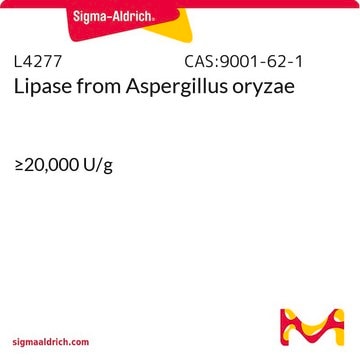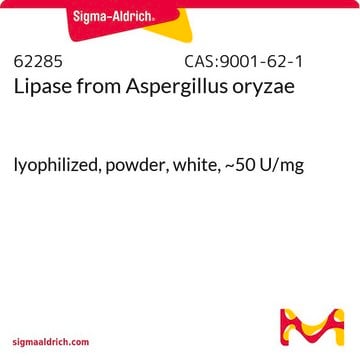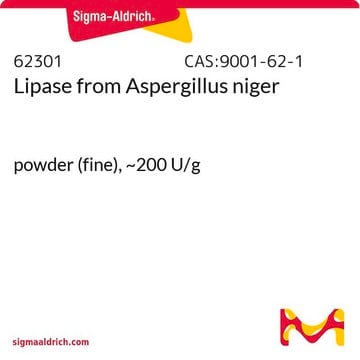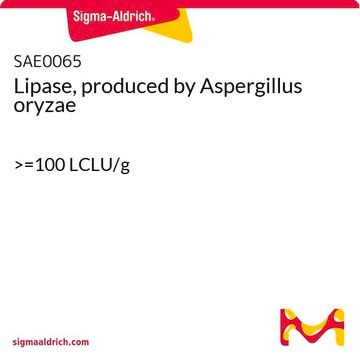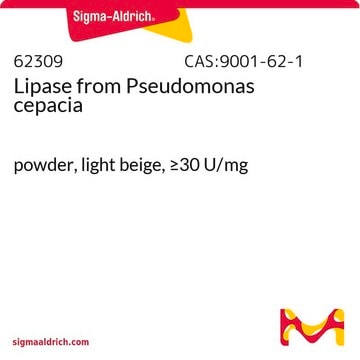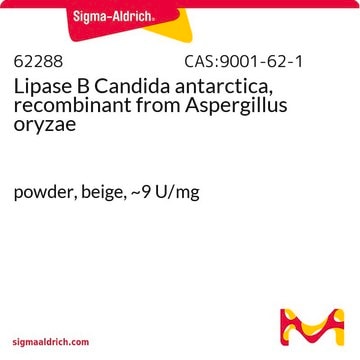L0777
Lipase from Aspergillus oryzae
solution, ≥100,000 U/g, white, beige
Sinónimos:
AOL, Lipolase 100L
About This Item
Productos recomendados
origen biológico
Aspergillus sp. (Aspergillus oryzae)
formulario
solution
actividad específica
≥100,000 U/g
condiciones de almacenamiento
(Tightly closed. Dry)
técnicas
cell based assay: suitable
color
beige
white
temp. de almacenamiento
2-8°C
InChI
1S/C11H9N3O2.Na/c15-8-4-5-9(10(16)7-8)13-14-11-3-1-2-6-12-11;/h1-7,16H,(H,12,14);/q;+1/b13-9-;
Clave InChI
QWZUIMCIEOCSJF-CHHCPSLASA-N
¿Está buscando productos similares? Visita Guía de comparación de productos
Descripción general
Lipase is derived from Aspergillus oryzae by ammonium sulfate precipitation and chromatography.Lipases or triacylglycerol acyl hydrolases are a group of hydrolase enzymes that are usually found in humans and animals with monogastric stomachs. Lipase enzymes are generally formed in the pancreas and stomach where they aid in fat and lipids digestion.(2)
Aplicación
- as a control enzyme in activity assays
- as a component in lipolase stock solution for the hydrolysis experiments
- to incubate scaffolds for lipase-accelerated degradation experiments
- as the lipolytic enzyme standard to detect lipolytic enzymatic activity via chromogenic agar plates and zymography
Acciones bioquímicas o fisiológicas
Nota de preparación
Información legal
Producto relacionado
anticuerpo
enzima
sustrato
Palabra de señalización
Danger
Frases de peligro
Consejos de prudencia
Clasificaciones de peligro
Resp. Sens. 1
Código de clase de almacenamiento
11 - Combustible Solids
Clase de riesgo para el agua (WGK)
WGK 1
Punto de inflamabilidad (°F)
Not applicable
Punto de inflamabilidad (°C)
Not applicable
Equipo de protección personal
Eyeshields, Gloves, type N95 (US)
Certificados de análisis (COA)
Busque Certificados de análisis (COA) introduciendo el número de lote del producto. Los números de lote se encuentran en la etiqueta del producto después de las palabras «Lot» o «Batch»
¿Ya tiene este producto?
Encuentre la documentación para los productos que ha comprado recientemente en la Biblioteca de documentos.
Los clientes también vieron
Nuestro equipo de científicos tiene experiencia en todas las áreas de investigación: Ciencias de la vida, Ciencia de los materiales, Síntesis química, Cromatografía, Analítica y muchas otras.
Póngase en contacto con el Servicio técnico